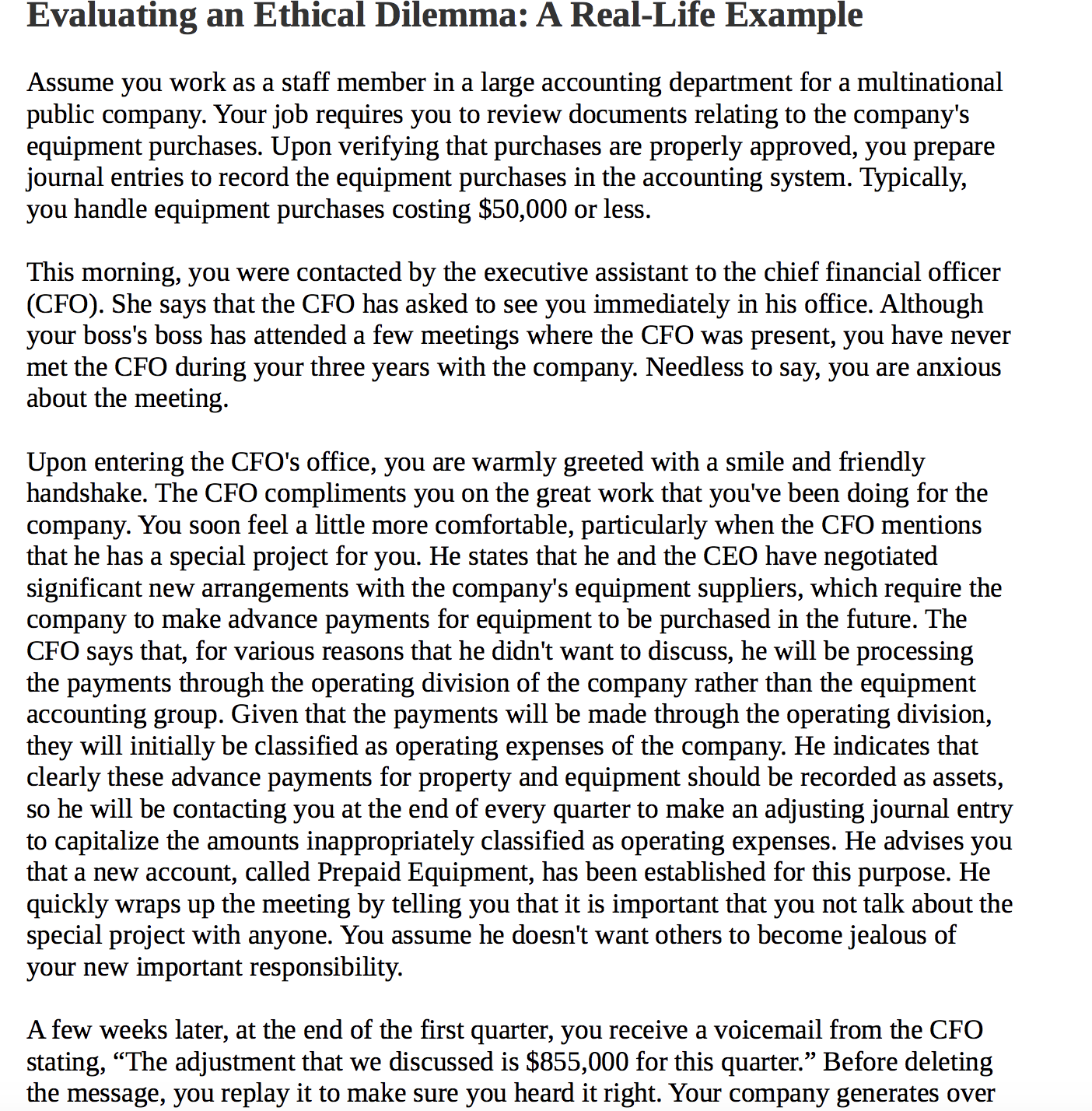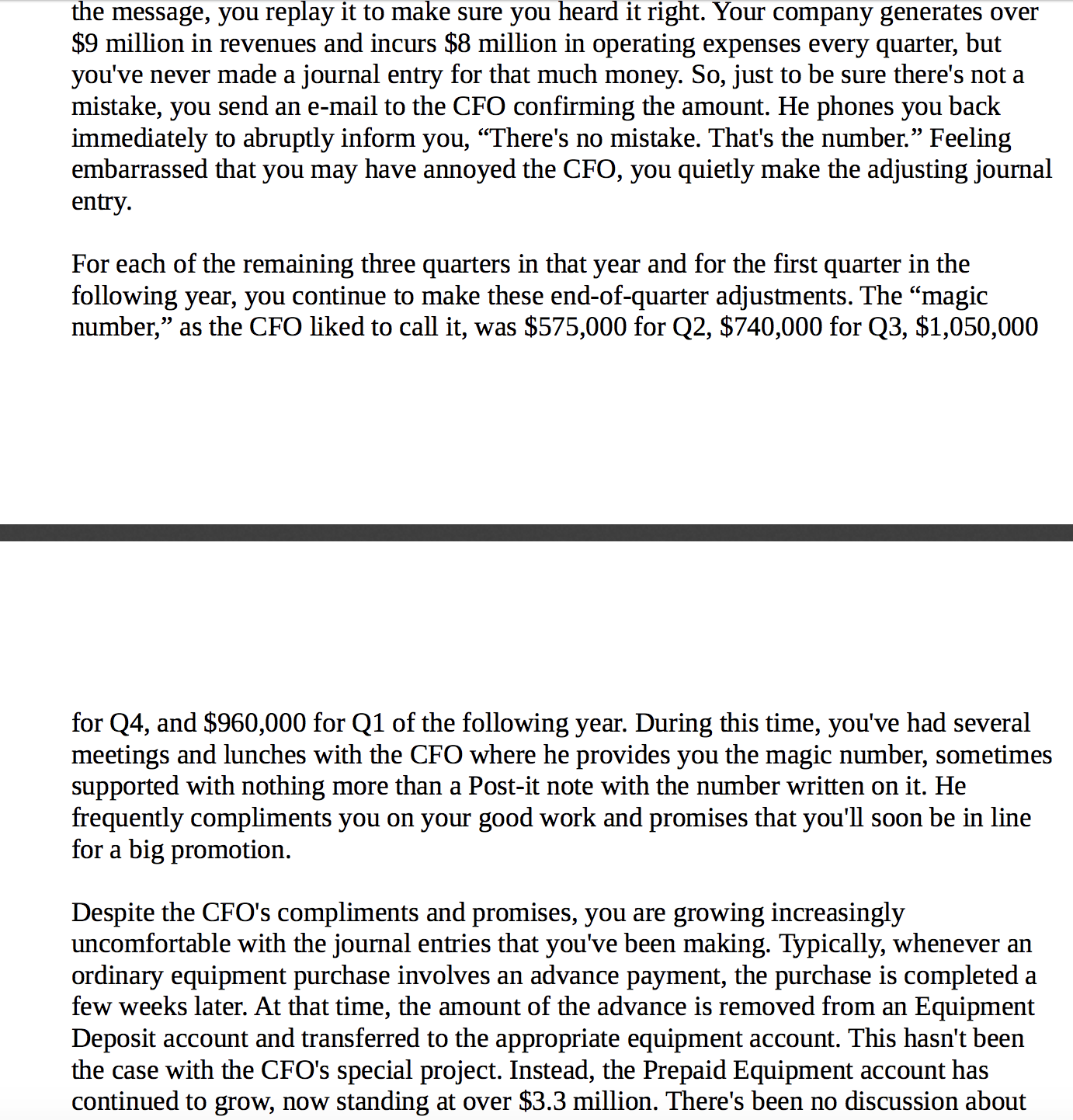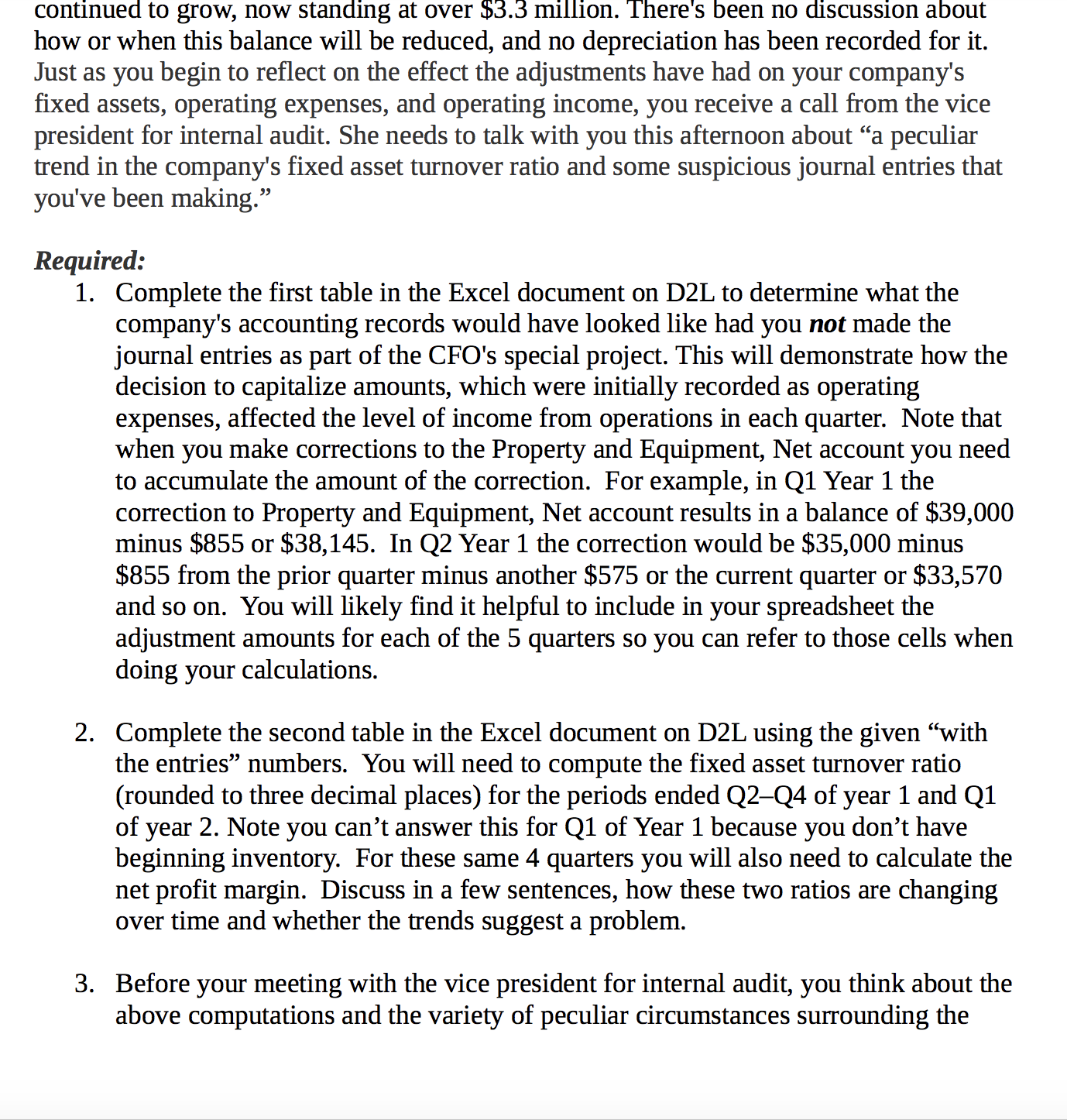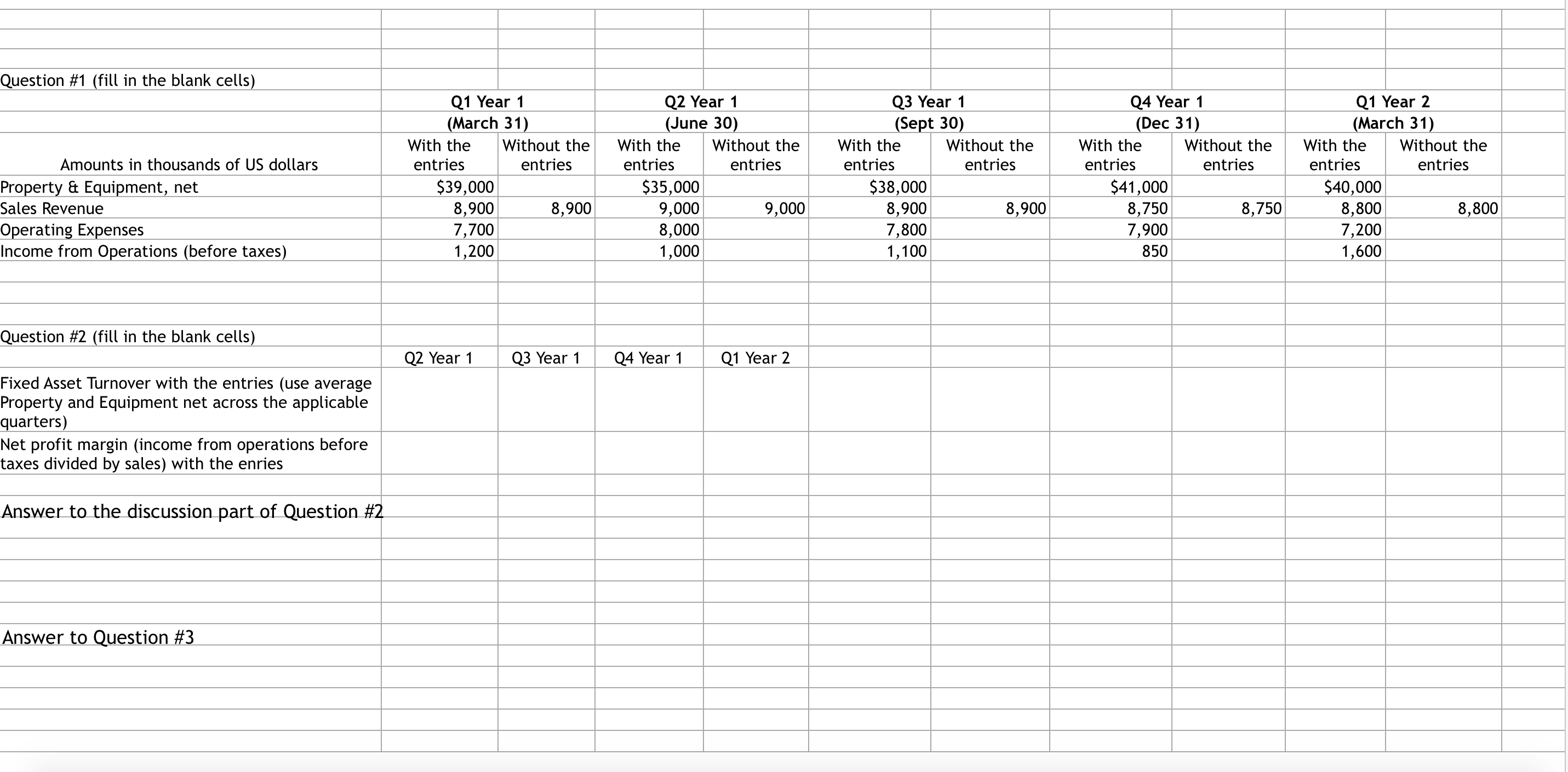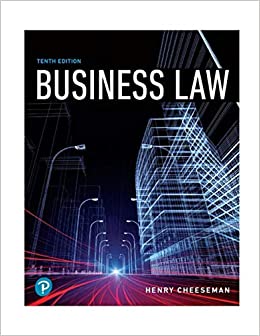Read and complete the below case. You should do all questions using one Excel worksheet in the Excel document provided on D2L. Complete the 2 tables provided on the Excel worksheet to answer questions #1 and #2. Use the provided four text boxes on the Excel worksheet to compete question #2 and to answer questions #3-#5. All of your analyses will be done using operating income (not net income after taxes) so you can ignore income taxes.
Evaluating an Ethical Dilemma: A Real-Life Example Assume you work as a staff member in a large accounting department for a multinational public company. Your job requires you to review documents relating to the company's equipment purchases. Upon verifying that purchases are properly approved, you prepare journal entries to record the equipment purchases in the accounting system. Typically, you handle equipment purchases costing $50,000 or less. This morning, you were contacted by the executive assistant to the chief financial officer (CFO). She says that the CFO has asked to see you immediately in his office. Although your boss's boss has attended a few meetings where the CFO was present, you have never met the CFO during your three years with the company. Needless to say, you are anxious about the meeting. Upon entering the CFO's office, you are warmly greeted with a smile and friendly handshake. The CFO compliments you on the great work that you've been doing for the company. You soon feel a little more comfortable, particularly when the CFO mentions that he has a special project for you. He states that he and the CEO have negotiated significant new arrangements with the company's equipment suppliers, which require the company to make advance payments for equipment to be purchased in the future. The CFO says that, for various reasons that he didn't want to discuss, he will be processing the payments through the operating division of the company rather than the equipment accounting group. Given that the payments will be made through the operating division, they will initially be classied as operating expenses of the company. He indicates that clearly these advance payments for property and equipment should be recorded as assets, so he will be contacting you at the end of every quarter to make an adjusting journal entry to capitalize the amounts inappropriately classified as operating expenses. He advises you that a new account, called Prepaid Equipment, has been established for this purpose. He quickly wraps up the meeting by telling you that it is important that you not talk about the special project with anyone. You assume he doesn't want others to become jealous of your new important responsibility. A few weeks later, at the end of the rst quarter, you receive a voicemail from the CFO stating, \"The adjustment that we discussed is $855,000 for this quarter.\" Before deleting the message, you replay it to make sure you heard it right. Your company generates over the message, you replay it to make sure you heard it right. Your company generates over $9 million in revenues and incurs $8 million in operating expenses every quarter, but you've never made a journal entry for that much money. So, just to be sure there's not a mistake, you send an e-mail to the CFO confirming the amount. He phones you back immediately to abruptly inform you, \"There's no mistake. That's the number.\" Feeling embarrassed that you may have annoyed the CFO, you quietly make the adjusting journal entry. For each of the remaining three quarters in that year and for the first quarter in the following year, you continue to make these end-of-quarter adjustments. The \"magic number,\" as the CFO liked to call it, was $575,000 for Q2, $740,000 for Q3, $1,050,000 for Q4, and $960,000 for Q1 of the following year. During this time, you've had several meetings and lunches with the CFO where he provides you the magic number, sometimes supported with nothing more than a Post-it note with the number written on it. He frequently compliments you on your good work and promises that you'll soon be in line for a big promotion. Despite the CFO's compliments and promises, you are growing increasingly uncomfortable with the journal entries that you've been making. Typically, whenever an ordinary equipment purchase involves an advance payment, the purchase is completed a few weeks later. At that time, the amount of the advance is removed from an Equipment Deposit account and transferred to the appropriate equipment account. This hasn't been the case with the CFO's special project. Instead, the Prepaid Equipment account has continued to grow, now standing at over $3.3 million. There's been no discussion about continued to grow, now standing at over $3.3 million. There's been no discussion about how or when this balance will be reduced, and no depreciation has been recorded for it. Just as you begin to reect on the effect the adjustments have had on your company's fixed assets, operating expenses, and operating income, you receive a call from the vice president for internal audit. She needs to talk with you this afternoon about \"a peculiar trend in the company's fixed asset turnover ratio and some suspicious journal entries that you've been making.\" Required: 1. Complete the first table in the Excel document on D2L to determine what the company's accounting records would have looked like had you not made the journal entries as part of the CFO's special project. This will demonstrate how the decision to capitalize amounts, which were initially recorded as operating expenses, affected the level of income from operations in each quarter. Note that when you make corrections to the Property and Equipment, Net account you need to accumulate the amount of the correction. For example, in Q1 Year 1 the correction to Property and Equipment, Net account results in a balance of $39,000 minus $855 or $38,145. In Q2 Year 1 the correction would be $35,000 minus $855 from the prior quarter minus another $575 or the current quarter or $33,570 and so on. You will likely nd it helpful to include in your spreadsheet the adjustment amounts for each of the 5 quarters so you can refer to those cells when doing your calculations. 2. Complete the second table in the Excel document on D2L using the given \"with the entries\" numbers. You will need to compute the fixed asset turnover ratio (rounded to three decimal places) for the periods ended Q2Q4 of year 1 and Q1 of year 2. Note you can't answer this for Q1 of Year 1 because you don't have beginning inventory. For these same 4 quarters you will also need to calculate the net profit margin. Discuss in a few sentences, how these two ratios are changing over time and whether the trends suggest a problem. 3. Before your meeting with the vice president for internal audit, you think about the above computations and the variety of peculiar circumstances surrounding the \"special project\" for the CFO. Discuss at least three things you think are peculiar circumstances surrounding the special project. . Your meeting with internal audit was short and unpleasant. The vice president indicated that she had discussed her findings with the CFO before meeting with you. The CFO claimed that he too had noticed the peculiar trend in the fixed asset turnover ratio, but that he hadn't had a chance to investigate it further. He urged internal audit to get to the bottom of things, suggesting that perhaps someone might be making unapproved journal entries. Internal audit had identified you as the source of the journal entries and had been unable to find any documents that approved or substantiated the entries. She ended the meeting by advising you to find a good lawyer. Discuss in a few sentences, how should you have handled the situation with the CFO in order to avoid your lawsuit. . In the real case on which this one is based, the internal auditors agonized over the question of whether they had actually uncovered a fraud or whether they were jumping to the wrong conclusion. The Wall Street Journal mentioned this on October 30, 2002, by stating, \"it was clear . . . that their findings would be devastating for the company. They worried about whether their revelations would result in layoffs. Plus, they feared that they would somehow end up being blamed for the mess.\" Beyond the personal consequences mentioned in this quote, disscuss in a few sentences what other groups could be affected by the findings of the internal auditors and how the findings would potentially affect them. Question #1 (fill in the blank cells) Q1 Year 1 QgYear 1 93 Year 1 Q4 Year 1 Q1 Year 2 (March 31) (June 30) (Sept 30) (Dec 31) (March 31) With the Without the With the Without the With the Without the With the Without the With the Without the Amounts in thousands of US dollars entries entries entries entries entries entries entries entries entries entries Property & Equipment, net $39,000 $35,000 $38,000 $41,000 $40,000 Sales Revenue 8,900 8,900 9,000 9,000 8,900 8,900 8,750 8,750 8,800 8,800 Operating Expenses 7,700 8,000 7,800 7,900 7,200 Income from Operations (before taxes) 1,200 1,000 1,100 850 1,600 Question #2 (fill in the blank cells) Q2 Year 1 Q3 Year 1 Q4 Year 1 Q1 Year 2 Fixed Asset Turnover with the entries (use average Property and Equipment net across the applicable quarters) Net profit margin (income from operations before taxes divided by sales) with the enries .. EC'Z W3
